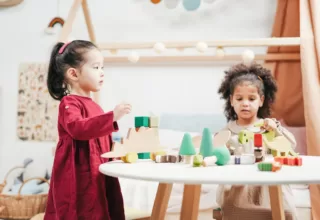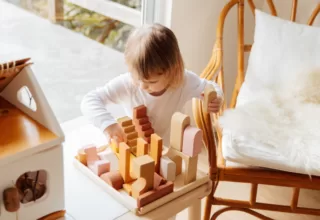Are there any toxic materials used in wooden toys?
Outline
- Introduction
- Benefits of wooden toys
- Materials used in wooden toys
- Potential toxic materials in wooden toys
- Safety standards and certifications
- How to ensure safety when buying wooden toys
- Conclusion
- FAQs
Wooden toys have been cherished by children and parents alike for generations. They offer a timeless charm and a tactile experience that is hard to replicate with plastic or electronic alternatives. With the growing awareness of environmental sustainability and concerns about toxic materials in children’s products, it’s natural to wonder if wooden toys are entirely safe. In this article, we will explore the materials used in wooden toys and whether they can pose any toxicity risks to children.
Introduction
Wooden toys are playthings made primarily from natural wood materials. They range from simple building blocks to intricate puzzles and dolls. In recent years, there has been a resurgence in their popularity as parents seek alternatives to plastic toys that are often associated with environmental issues and potential health risks.
Benefits of wooden toys
Wooden toys offer several advantages over their plastic counterparts, making them a preferred choice for many parents.
Durability and longevity
Wooden toys are renowned for their durability and longevity. They can withstand rough play and are less likely to break or wear out compared to plastic toys. This durability means they can be passed down through generations, reducing waste and promoting sustainability.
Environmental sustainability
Wooden toys are made from renewable resources, unlike plastic toys that are derived from non-renewable fossil fuels. Wood is biodegradable, making it a more eco-friendly option. Additionally, many wooden toy manufacturers use sustainably sourced materials and employ responsible production practices.
Safety for children
Wooden toys are generally considered safe for children. Unlike plastic toys that may contain harmful chemicals like phthalates or bisphenol A (BPA), wooden toys are free from these concerns. The absence of small parts or sharp edges in well-designed wooden toys also minimizes the risk of choking or injury.
Encouraging imaginative play
Wooden toys often have a simple and open-ended design, allowing children to use their imagination and creativity during play. They can be transformed into various objects or characters, fostering cognitive development and problem-solving skills.
Materials used in wooden toys
To ensure the safety and quality of wooden toys, it’s essential to understand the materials used in their construction.
Types of wood commonly used
Wooden toys are typically made from hardwood or softwood. Hardwood, such as oak, maple, or beech, is known for its strength and durability. Softwood, like pine or cedar, is lighter and easier to work with. Both types of wood can be used to create high-quality toys, but hardwood is generally more preferred due to its durability.
Natural finishes and dyes
To enhance the appearance and protect the wood, manufacturers often apply natural finishes to wooden toys. These finishes may include beeswax, linseed oil To enhance the appearance and protect the wood, manufacturers often apply natural finishes to wooden toys. These finishes may include beeswax, linseed oil, or food-grade mineral oil. These natural options are generally considered safe and non-toxic, providing a smooth and durable surface without the need for potentially harmful chemical coatings.
When it comes to coloring wooden toys, some manufacturers may use natural dyes derived from plants or vegetables. These dyes are generally safe and non-toxic, adding vibrant hues to the toys without compromising safety.
Adhesives and glues
In the construction of wooden toys, adhesives and glues are sometimes necessary to join different parts together. The majority of manufacturers use non-toxic, water-based adhesives that are free from harmful chemicals like formaldehyde or volatile organic compounds (VOCs). These adhesives are specifically formulated for use in children’s products and adhere to strict safety standards.
Potential toxic materials in wooden toys
While wooden toys are generally safe and non-toxic, there are some potential risks associated with certain materials that may be used in their production.
Paints and coatings
Some wooden toys may be painted or coated with decorative finishes. It’s important to ensure that the paints used are non-toxic and free from lead, heavy metals, or other harmful substances. Reputable manufacturers adhere to safety regulations and use water-based, child-safe paints that meet stringent standards.
Chemical treatments and preservatives
Certain types of wood used in the construction of wooden toys may undergo chemical treatments or be treated with preservatives to enhance their durability or protect against pests. While these treatments are typically safe, it’s crucial to ensure that the chemicals used are non-toxic and meet safety standards. Look for toys made from untreated or naturally treated wood to minimize any potential risks.
Imported toys and safety regulations
When purchasing wooden toys, especially those imported from other countries, it’s essential to be vigilant about safety regulations. Different countries may have varying safety standards and regulations for children’s products. Ensure that the toys comply with the safety standards of your region and that they undergo proper testing and certification.
Safety standards and certifications
To address concerns about the safety of wooden toys, various standards and certifications have been established to ensure their compliance with safety guidelines. Some of the prominent standards include:
ASTM F963 and EN 71 standards
ASTM F963 is a safety standard established by the American Society for Testing and Materials (ASTM) for toy safety in the United States. EN 71 is a similar standard adopted by the European Union. These standards outline specific requirements and test methods for toys, including wooden toys, to ensure they are safe for children.
Third-party testing and certifications
In addition to adhering to safety standards, many manufacturers voluntarily submit their wooden toys for third-party testing and certification. These certifications provide an extra layer of assurance that the toys have undergone rigorous testing and meet the required safety criteria. Look for certifications such as the Consumer Product Safety Improvement Act (CPSIA) compliance in the United States or the CE marking in the European Union.
Consumer awareness and research
As a responsible consumer, it’s important to stay informed and conduct research when purchasing wooden toys. Look for reputable brands and manufacturers with a track record of producing safe and high-quality toys. Read product descriptions, customer reviews, and safety information provided by the manufacturer. Additionally, organizations such as consumer advocacy groups may provide valuable insights and recommendations on safe toy choices.
How to ensure safety when buying wooden toys
To ensure the safety of wooden toys for your children, consider the following tips when making a purchase:
Research the manufacturer
Before purchasing wooden toys, take the time to research the manufacturer. Look for well-established brands with a reputation for producing safe and high-quality toys. Check their website, read customer reviews, and see if they provide information about their safety practices and materials used.
Look for safety certifications
Safety certifications provide an additional level of assurance when buying wooden toys. Look for toys that carry certifications such as ASTM F963 or EN 71, which indicate that the toys meet specific safety standards. Keep in mind that not all manufacturers may seek certifications, especially smaller artisans, so it’s important to consider other factors as well.
Check for proper labeling
When purchasing wooden toys, look for clear and accurate labeling. The toy should have the manufacturer’s information, recommended age range, and any safety warnings or precautions. Ensure that the toy is suitable for your child’s age and developmental stage.
Avoid cheap and uncertified toys
While budget-friendly options may be tempting, it’s essential to prioritize safety over price. Cheaply made wooden toys may not adhere to safety standards or undergo proper testing. Avoid purchasing toys from unknown or unreliable sources and opt for reputable sellers or retailers.
Conclusion
Wooden toys have a long-standing appeal due to their durability, environmental sustainability, and safety features. While there may be potential risks associated with certain materials used in wooden toys, reputable manufacturers prioritize safety and adhere to rigorous standards. By conducting research, looking for safety certifications, and being mindful of potential risks, parents can confidently choose safe and non-toxic wooden toys for their children.
FAQs
Q1: Are all wooden toys safe for children?
Not all wooden toys are created equal in terms of safety. It’s important to choose toys from reputable manufacturers who prioritize safety and adhere to relevant standards and certifications.
Q2: Can wooden toys cause allergies in children?
Wooden toys, especially those with natural finishes and dyes, are generally hypoallergenic. However, some children may have specific allergies, so it’s important to check the materials used in the toy’s construction and consult with a healthcare professional if you have concerns.
Q3: How can I clean wooden toys?
Cleaning wooden toys is usually straightforward. Wipe them with a damp cloth and mild soap, ensuring they are thoroughly dried afterward. Avoid submerging wooden toys in water or using harsh chemicals that may damage the wood or finishes.
Q4: Are wooden toys more expensive than plastic toys?
Wooden toys can vary in price, but they are often perceived as more durable and long-lasting, justifying their slightly higher cost. Additionally, the environmental sustainability and non-toxic nature of wooden toys make them an attractive choice for many parents.
Q5: Where can I find reputable manufacturers of wooden toys?
Reputable manufacturers of wooden toys can be found online or in specialty toy stores. Look for brands with positive reviews, safety certifications, and transparent information about their materials and production processes.
How useful was this post?
Click on a star to rate it!
Average rating 5 / 5. Vote count: 2
No votes so far! Be the first to rate this post.



